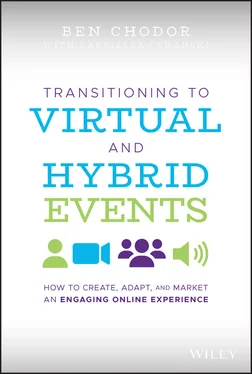In this chapter, you'll get a basic understanding of virtual and hybrid events, including benefits and challenges, and I will also clear up some common myths and misconceptions about taking your events virtual.
A virtual event is a meeting or conference that either was originally held as a physical event and moved to be online or was created to exist only online. The only way that you can access and attend the event is via the internet from a computer, laptop, mobile device, or OTT (over the top) on a Smart TV.
Enterprise companies have been pushed to come up with new and innovative ways to connect with their customers, partners, and prospects. For years, large physical events have been a great way to network with these audiences and share new innovations, products, and services. Today, organizations have to turn to 100% virtual or hybrid events to extend the reach of their content, attract more interest in their company, and stay in touch with their investors, members, partners, and employees. The rapidly evolving event technology space has enabled companies to have thousands of additional people engage with a virtual event and keep them coming back to view on‐demand after the event has ended. So instead of being at a physical event they are now participating from their home or office from any corner of the world.
A major benefit of the hiatus from in‐person event delivery is that it has forced in‐person events teams to finally embrace virtual delivery in ways that would not have been possible if they'd been focused on the production cycle of in‐person events. Out of this hiatus has come an intense focus on how to integrate digital delivery of content: either as virtual‐only or (in the future) as a mix of staged in‐person and virtual delivery. The latter will be important because when in‐person events do return, social distancing measures will continue to heavily impact the way events are staged, requiring larger space footprints to stage them, which will impact revenue and margins and can only be offset by the thoughtful integration of virtual delivery to enhance reach and drive ROI for sponsors.
Like most of us who were forced by COVID‐19 to transition from in‐person events to virtual‐only and hybrid delivery models, you're going to learn a lot about this transition and the limitations of traditional program formats built around in‐person attendees. What works for an in‐person event does not necessarily translate to success online. You'll need to innovate and look at things differently, in terms of the types of content, the duration of sessions, and speaker and topic selection. Some considerations in this new virtual events world include:
Pre‐Event Research: gather questions to help shape the programs, and leverage integrated channel marketing to foster meaningful audience engagement.
Content Integration: work to align content produced at virtual events within your year‐round content strategy so you're able to continually nurture audiences.
Value of Curation: analyze what is the best way to capture your content. You may find it's better to record sessions with certain speakers so you can spend the time after the content is recorded to edit and create a more dynamic presentation. However, other speakers may be better captured live.
“As an information services company, we have recently invested significantly in our virtual events products and platform, because we understood the value and importance of the channel in distributing content to our most engaged audiences. An analysis of our audience data revealed that our virtual attendees are among our most loyal and engaged audiences, often spending hours consuming and interacting with our brands and branded content, all the while generating unique perspectives and insights on industry topics, products, or trends. In fact, most of our top customers have grown with us through deeper adoption of our virtual events platform.”
—John Whelan, CEO of the Cyber Risk Alliance
You can leverage the brand trust that you've established among your attendees and customers to migrate them to virtual delivery in lieu of in‐person delivery without impacting revenue.
Virtual event attendees are a rich source of data insight to build programs to deepen the relationship between your brand and customers. You can also use the insight to cultivate market and customer perspectives, which can allow you to significantly enhance the value of your marketing solutions.
Having established the strategic value of your virtual event audience, you can make them the focal point of your content and audience growth strategy, seeking to expand the range of content and programming on your virtual event platform, and to position interaction as a core component of your customer's journeys.
OPTING FOR A HYBRID EVENT
A hybrid event is a physical event that has a portion or the entire content program available online; bottom line, there is always a physical element to a hybrid event.
The obvious and immediate appeal is the expanded reach you have to engage a larger audience that doesn't attend the physical event. We know for the foreseeable future, events will be virtual and even when we go back to physical events you will still see a virtual/hybrid portion of the program included; the world has changed forever. Think of the hybrid element of your event as your event insurance policy going forward. It is your continuity plan in this unpredictable world we now live in. When I first got into the world of streaming and virtual events, a lot of event organizers would be worried that if they offered their event and programming online, that they would have fewer people attend the physical event because attendees would decide to stay home and watch online and they would make less money from the event.
I used to tell clients, prospects, and anyone who could hear my voice, that virtual events do not cannibalize physical events. In fact a good virtual event will make the virtual attendee want to attend physically and it would give you the ability to grow your audience and keep your event going after the physical event ended, but a lot of event planners were still too scared about the risk of cannibalization of their event and could not see the value of bringing their events virtual. Well guess what: it's not that virtual events are cannibalizing your physical events, it's that the world has now cannibalized your physical event.
Many forward‐thinking companies have and will use hybrid events to increase their audience across geographical divides and further their education and communication. Despite fears of dropping in‐person attendance, data suggests that physical face‐to‐face participation increases with hybrid events. Hybrid events also extend the reach and life of your content, allowing companies to tap into new markets, acquire new attendees/users, and open the doors to more business opportunities and engagements. As we think about going back to some sort of physical event, I believe you should add a virtual or hybrid element to any meeting or conference you are planning now or in the future; the technology is finally here to enable you to easily do it.
As I look to the future, I believe we will start with smaller physical events, let's say audience sizes up to 100 or so people meeting simultaneously in various cities around the country or even around the world at the same time, and you will be streaming/broadcasting to and from each of the locations and to a virtual audience, all at the same time. I believe even when you plan meetings with thousands of attendees, you will have satellite/hybrid audiences at various physical locations and a virtual audience participating from home or their offices.
Читать дальше












